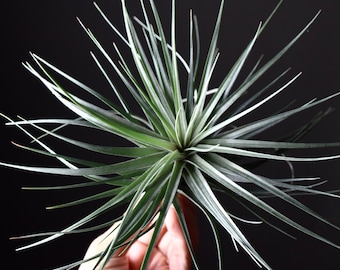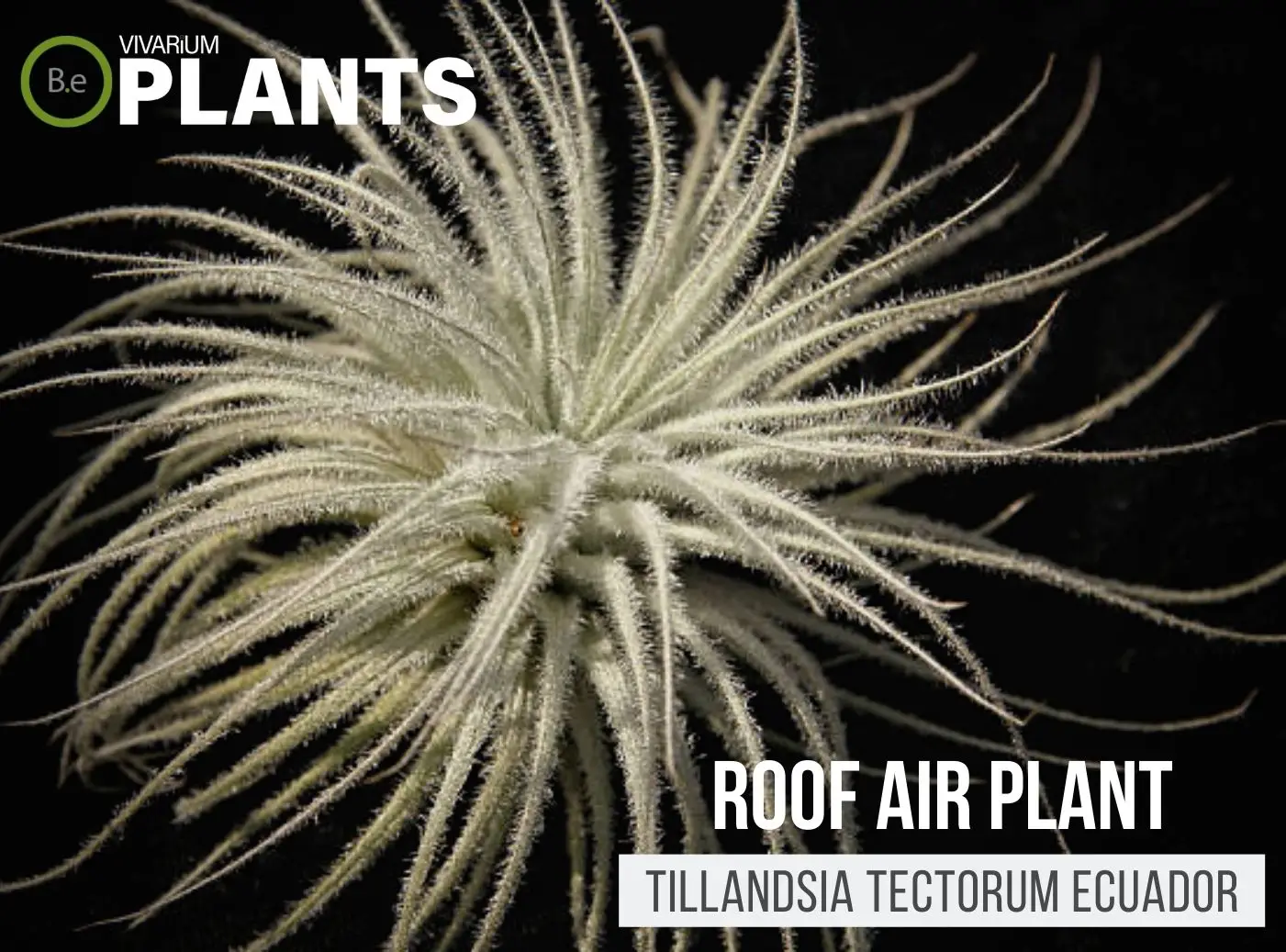Tillandsia bergeri, otherwise known as the Tillandsia aeranthos bergeri, is an increasingly popular terrarium air plant that is sure to bring beauty and unique touch to any interior space.
Native to the mountains of South America, this exotic species of the bromeliad family boasts soft, velvety foliage and large, bright pink or purple blooms.
Not only can you grow it in your terrarium, but it also looks stunning on its own as a single-potted specimen.
Unlike many terrarium plants, Tillandsia bergeri is incredibly easy to care for and can thrive with minimal maintenance.
With its attractive, low-maintenance features, this eye-catching Tillandsia species is an excellent choice for adding a unique and exotic flair to your living space.
| Quick Stats: | |
|---|---|
| Scientific Name | Tillandsia aeranthos bergeri |
| Common Name | Bergeri, Tillasndsia bergeri, Mad pupper |
| Family Name | Bromeliaceae |
| Habitat | Cloud Forrest |
| Temperature | 65°F to 80°F |
| Height | 4 to 10 inches |
| pH | 5.5 to 6.5 |
| Lighting | Bright, indirect |
Table Of Contents:
ToggleWhat is a Tillandsia Bergeri?
Tillandsia Bergeri is an epiphytic species of Bromeliad native to cloudy and wet parts of Central and South America.
This plant is best known for its long, thin, and stiff rosette of brightly colored green leaves that form an urn shape.
The center of the rosette will hold a flower, which is also typically pink or purple.


Tillandsia Bergeri Facts
The leaves of Tillandsia bergeri are known to form different shapes, depending on how they are cared for and where they are placed in the terrarium.
Many fly larvae and moths find the urn shape of this Bromeliad to be a great hiding place or a source of food.
Description
Bergeri has thin, tough, pointy leaves with a long, pointed central flower spike that holds magnificently colored purple and pink flowers.
This plant grows best when suspended from the vivarium ceiling and can reach up to 10″ tall.
Habitat
The native environment of the Bergeri is cloud forests, and although it is often found in more tropical regions, you don’t need a tropical terrarium.
It can also be found in mountainous regions in cooler weather, where it survives off the clouds and their condensation.
pH Preference
Tillandsia bergeri prefers slightly acidic soil with a pH range of 5.5 to 6.5.
In the wild, it grows on damp, shady surfaces or in deciduous trees, so it prefers humid conditions.
Vivarium Type
The Bergeri is quite an easy-going species. With that in mind, it will not be too complicated when it comes to choosing the type of enclosure it is grown in.
It is best to try and replicate the plant’s natural habitat as much as possible.
Doing so will make it easier to provide this air plant with its basic needs.
The proper setup and theme of the enclosure will make a big difference to the overall look and health of the plant.
Be sure to choose setups that are moist and high in humidity.
Here are recommended vivariums it will do well in:
-
- Paludariums – Half aquatic/ half terrain-based enclosure.
-
- Terrariums – Fully terrain-based enclosures with little to no aquatic features.
Vivarium Placement
The ideal placement for this Bromeliad is to suspend it from the ceiling or a branch using cotton thread or fishing wire.
To get the best results and make sure the plant is happy, make sure the cotton or fishing wire will not damage the vivarium in any way.
Substrate
Tillandsia bergeri prefers a sphagnum or reindeer moss substrate, as it retains moisture, which is key to this plant’s health.
If a live moss substrate is too difficult to manage, other types of terrarium soil can also be used, such as cactus soil or high-grade potting soil.
Lighting
This plant prefers bright, indirect light and should not be exposed to direct sunlight for long periods of time.
Instead, use cooler-toned LED terrarium lights to mimic the cloudy environment of the highlands, which will give the Bergeri a pleasing environment without the threat of burning.
Buy Tillandsia Bergeri
When it comes to buying a Bergeri, there are a few things to keep in mind.
Making sure the plant is healthy when purchased is essential for its success in a vivarium.
Vegetation that is already in poor conditions will have a very hard time adjusting to new environments.
Click the image below to find out more about the current price and other relative info about this plant.
Tillandsia Bergeri Care and Propagation
Tillandsia bergeri is a relatively easy plant to care for as long as a few basic rules are followed.
This plant does not require much in the way of fertilizer to thrive and grow, with the exception of providing an occasional dose of Epsom salt.
To propagate these plants, it is simply a matter of carefully removing the pup from the mother and planting them in a new substrate.
How to Grow
To keep the Bergeri healthy, make sure to mist it every other day or every several days if you don’t live in a very humid climate.
For best results, mist the Bromeliad until it’s soaked and then allow it to dry out before repeating.
In addition, it’s believed that these plants enjoy a light layer of organic compost or fertilizer every few weeks.
Watering
Water this plant by misting it with distilled or RO water.
Use water that is either room temperature or slightly warmer.
Keeping the leaves moist is important, but too much watering will result in the leaves rotting.
Make sure to allow enough airflow to avoid mold and bacterial growth.
Plants Similar to Tillandsia Bergeri
Adding diversity to an enclosure is key to an aesthetically pleasing setup.
Try mixing up the look of your vivarium with different flora that can easily co-exist in the same types of environment.
Furthermore, if you find the Bergeri hard to acquire or would like to consider something similar to this terrarium plant…
Here are other air plants you might find will do well with or in the place of Tillandsia bergeri:
Conclusion
For those looking to bring a touch of the wild and exotic into their home, Tillandsia bergeri is definitely a great choice.
From its colorful blooms to its soft foliage, there’s plenty to appreciate about this unique species of the bromeliad family.
Plus, it’s easy to care for nature and low-maintenance requirements make it an ideal terrarium plant for even the most novice of gardeners.
If you’re looking to add a splash of color and intrigue to your terrarium, Tillandsia bergeri is a perfect choice.
Frequently Asked Questions
Tillandsia Bergeri require minimal care and grow in bright, indirect sunlight. For optimum growth, keep them in warm environments, water them with a mist spray or dip them in water occasionally, and provide them with plenty of humidity. Regularly remove any dead or decaying leaves and avoid exposing them to direct sunlight in order to keep your plants healthy and vibrant.
No, Tillandsia (Air Plants) do not need full sun to thrive. They prefer bright, indirect sunlight, and should be kept out of direct sun to avoid sun burning.
Tillandsia (air plants) should be watered once or twice a week by soaking in water for 15–20 minutes. The number of waterings will depend on the environment the plant is growing in. The hotter and drier, the more that the plant will need to watered or misted.
To keep your tillandsia bergeri blooming, make sure to provide plenty of bright, indirect light and mist them daily so they stay hydrated. You can also soak them in water 1–2 times a week to help encourage flowering.
After flowering, Tillandsia goes into a resting period and must be given extra water and nutrients to prepare for the next bloom.
| Characteristics: | |
|---|---|
| Common Name | Peruvian Shield Mantis, Rhomboid Mantis, Cobra Mantis |
| Family Name | Mantidae |
| Scientific Name | Choeradodis Rhomboidea |
| Use | Pets |
| Temperament | Non-aggressive |
| Lifespan | 6 to 10 Months |
| Diet | Insectivore |
| Adult Size | 1.7 to 3.5 in |
| Breeding Type | Egg Layer |
| Care Level | Moderate |
| Minimum Tank Size | 1 to 5 Gallons |
| pH | 7.0-8.0 |
| Hardness | Moderate |
| Temperature | 64-82°F |




